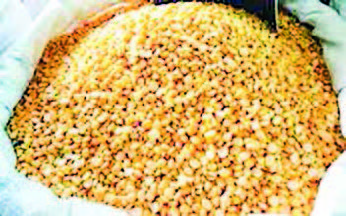The chickpea prices bounced back on 20 April after a high influx of new chickpeas in the market drove the prices down before the Thingyan holidays, according to Mandalay wholesale depot figures.
The prices stood at K232,000-257,000 per viss on 20 April. High demand by oil millers and growers who store the seeds for planting in the following season outstripped supply in the market in the second week of January 2024, causing the prices to peak at K287,000-K315,000 per viss on 12 January.
Chickpeas are heavily reliant on domestic consumption. Therefore, the demand for millers is highly correlated with price fluctuation, according to the Mandalay commodity depot.
Chickpeas are commonly cultivated in October-November and harvested in January-April. It is primarily grown in Bago, Ayeyawady, Sagaing, Magway and Mandalay regions.
The country primarily cultivates paddy, corn, cotton, sugarcane, various pulses and beans. Its second-largest production is pulses and beans, accounting for 33 per cent of agro-produce and covering 20 per cent of growing acres. Among them, black beans, pigeon peas and green grams constitute 72 per cent of bean acreage. Other beans, including peanuts, chickpeas, soybeans, black-eyed beans, butter beans and rice beans, are also grown in the country. Myanmar’s agriculture sector is the backbone of the country’s economy, and it contributes significantly to the gross domestic product (GDP). Myanmar’s pulses are one of the leading agricultural products.
Myanmar ships a small volume of chickpeas to foreign markets beyond self-sufficiency. More than 58,000 kilogrammes worth US$37.478 million were exported to foreign trade partners in the financial year 2023- 2024 (April-March), according to the Ministry of Commerce’s statistics.
Myanmar exported over 18,000 kilos of beans worth $13.139 million in the FY 2022- 2023. — NN/EM



